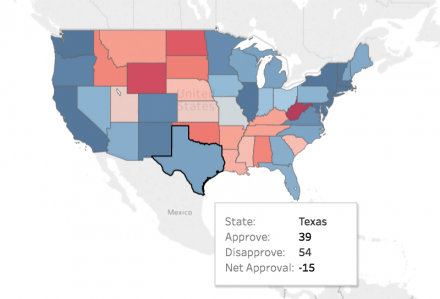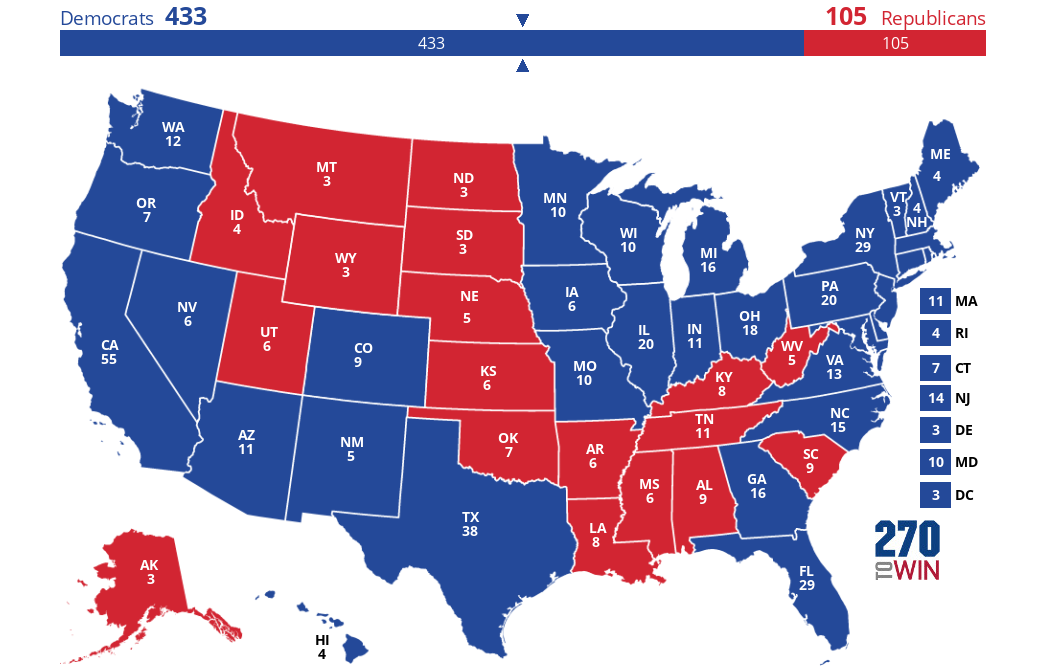Thanks to Gallup, we now have a state-by-state map of Trump’s approval ratings for 2017.
Sort of what you expect when you have a Republican president with an approval rating in the 30s. Take the 2018 results and adjust for the president’s approval ratings, and the usual suspects are deep blue. The purples are turning blue. The reds are less red, some turning purple. And Texas…
Texas? Look at Texas! Trump’s approval:disapproval is 39-54 in Texas! Texas has lower approval rates than Michigan, Wisconsin, Nevada, Pennsylvania, New Hampshire, and Maine! Could be a combination of unhappy Hispanic folks, other folks who like their Hispanic neighbors, and disdain for a border wall along the Rio Grande, are combining to drive down Trump’s approval in Texas disproportionate to the rest of the nation. Here’s the map. (Click on image for interactive version.)
What does this all mean? Nothing, really. Except that if Trump 2020 carries all the states where he has a net positive approval rating, and loses the net negative states to a Democrat, the 2020 Electoral College will become the new Trump University, in which American voters school Donald on modern expectations for a president.


 Click the map to create your own at
Click the map to create your own at
It is important to remember that he also won the Electoral College with a 40% approval rating and 60% disapproval rating and a popular vote total of only 43%. At this time in 2013, Hillary Clinton was the most admired person in America with an 80% approval rating and Donald Trump was a punchline at the White House Correspondents Dinner.
It is statistically misleading to assume the disapproval rating is the same thing as an affirmative vote for a hereto unknown 2020 Democratic nominee. Hubris is the enemy of effective campaigns.
I would also add that 9 months is a long time in politics and the Teflon may finally be wearing off of Charlie Baker. Let’s work our tails off to restore progressive governance to our commonwealth and our country and not lazily rely on the loathsomeness of the other side to do the heavy lifting only inspiring candidates and affirmative message canz
I agree this can be meaningless, especially if the Democrats don’t work hard at a strategic plan for turning a fertile field into a golden harvest.
The opportunity is before us. Let’s get this right.
All the same, thanks for an interesting post.
Same goes for the generic House ballot for which we are ahead by 16 points. Of course I prefer that to 16 points behind, but individual races matter.
The DACA shutdown was a strategic blunder. If we can recover an economics centered message, than I think we can reverse the gains the GOP has made on the generic ballot and in the Electoral College in 2020.
I see a vacuum that Democrats, so far, are reluctant to take advantage of. With this many voters unhappy with The Trump Party (which is what the Republican Party has become), we still have no viable alternative to offer.
I certainly would not expect the opposition party to have a single viable alternative this far out from the next election.
I agree it is early to go public with a platform. What would be your ideal timetable for that?
I thought he meant alternative individual, as in obvious frontrunner for our next presidential nomination. Regarding a platform or similar if Dems want their own Contract With America for 2018 they should get on that stat, and it should include the restoration of constitutional governance.
According to Wikipedia, Barack Obama announced his candidacy on 10-Feb-2007. He went on to win the 2008 presidential election.
I expect interesting announcements for the 2020 primary to begin in early 2019.
Though several of those red states are places where were defending Senate seats, or hope to pick one up
Marcus makes a great point and I am actually quite bullish on Beto O’Rourke upsetting Cruz in November. I am also bullish on AZ and NV flipping while we successfully defend MO. WV, and SD. The only R gain I see may be in Indiana, where Donnelly’s numbers are not as great and the GOP bench is slightly stronger. The Senate is still an uphill battle, but a winnable one. We will likely see a lot of governorships flip back to blue, hopefully even here in the “bluest state”.
What those maps indicate is Trump (and I’d argue the Republican party as a whole) is suffering in states that have some population density and/or significant population centers. He’s basically trying to ride a massive rural and exurb advantage to victory. The key for the Dems will be to crush it in cities and their immediate suburbs. We saw that play out in the Alabama Senate election. The PA special election for the House just outside Pittsburgh could be another proving ground.
People in and near cities see enough of the other that they get how wrong Trump’s brand of divisiveness is.